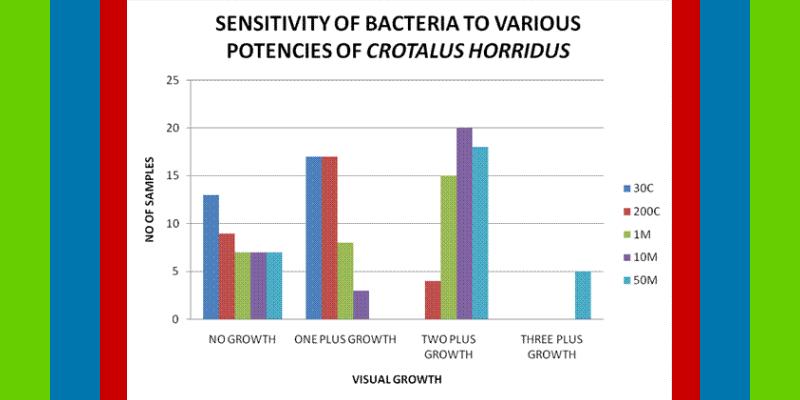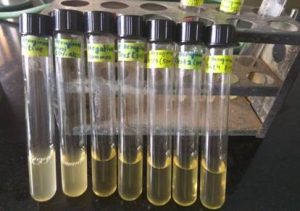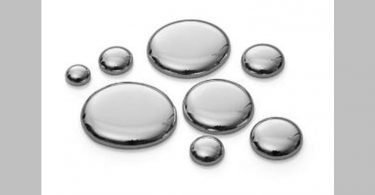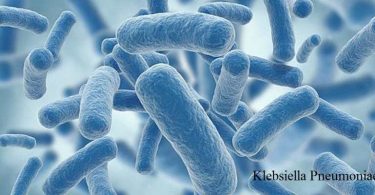The study is “In vitro antibacterial activity of crotalus horridus on Pseudomonas aeruginosa.” The study was done by DILUTION METHOD of sensitivity test of antimicrobial assay. The positive control contained P. aeruginosa culture without medicine and a negative control contained nutrient broth with no medicine, The alcohol control contained nutrient broth, culture and 20 drops of 90 % alcohol. The test control 1,2,3,4,5 contained nutrient broth, culture of P. aeruginosa and 20 drops of crotalus horridus 30C, 200C, 1M, 10M, 50M in test tube 1,2,3,4,5 respectively. These all test tubes were kept for incubation for 24 hours in incubator. After 24 hours the results were measured with visual growth of bacteria in the test tube as +, ++, +++ as rating of turbidity and compared with positive control, negative control and 90% alcohol control. The study was done on 30 samples of clinical isolates of P. aeruginosa from various age groups, both sexes, and all discharges of patient.
The result of study was represented in statistical data in the form of tables and graphs. The study shows sensitivity of P. aeruginosa to crotalus horridus 30CH potency more than that to other potencies.
Key Words- antibacterial activity, dilution method, crotalus horridus, homoeopathy
INTRODUCTION
BACKGROUND- India is a developing country and incidences of infectious diseases are becoming a common problem due to certain environmental changes, socioeconomic conditions and demographic factors. New infectious agents have been detected worldwide.[1] Pseudomonas aeruginosa is a common gram negative rod shaped bacteria which is more commonly found in hospital infections. It is a multidrug resistant [MDR] pathogen. Because of this it is very difficult to treat, and many antibiotics fail. .[1] Pseudomonas causes various infections like nail bed infection, bed sores, infections in burns, septicemia, endocarditis, formation of blue pus etc.[2]
As homoeopathy has many remedies for various disease conditions it also treats these conditions. The harmful stimuli from these bacteria cause disturbance in the vital force. This disturbance is corrected or cured by homoeopathic remedies in a gentle way, without harming the patient.
Crotalus horridus is homoeopathic remedy which is prepared from snake venom. This remedy mainly acts on septic conditions, gangrene, and decomposition of tissues producing putrid and malignant conditions.[3]
JUSTIFICATION FOR STUDY- As mentioned in Homoeopathic Materia Medica Crotalus horridus acts mainly on suppurative conditions. Crotalus was selected as an antibacterial agent against pseudomonas, because most of the infectious diseases caused by pseudomonas signs and symptoms similar to Crotalus.
MATERIALS AND METHODS
Study Settings – The study was done (in vitro) at microbiology laboratory of Rajiv Gandhi Institute Of IT And Biotechnology BharatiVidyapeeth, Pune.
Media and Chemicals- All media were procured from Hi Media, Mumbai, India.
Homoeopathic Drug Preparation- Homoeopathic drug Crotalus in 30 CH, 200 CH, 1M, 10M, 50M With their liquid dilutions was obtained from Dr. Wilmar Schwabe India Pvt. Ltd.
Organism- Pseudomonas Aeruginosa was used as standard culture to examine antimicrobial activity. The culture were prepared from clinical isolates. 30 samples were collected and tested.
Anti-microbial assay- Antimicrobial assay was performed using L-B Media, Nutrient Broth media, and Muller Hinton agar plates. The antimicrobial assay was done by using well diffusion method and dilution method. Inclusion criteria- samples were collected as clinical isolets of all discharges of all age group of both sex. Exclusion criteria- HIV, Gonorrhoea, Syphilis, and other STD’S were excluded.
Outcome assessment- The readings were reported as P. Aeruginosa was insensitive, sensitive, or resistant to Crotalus on the basis of the rate of visual turbidity of overnight dilutions, as per Dilution method.
RESULT AND OBSERVATIONS
| VISUAL TURBIDITY | ||||
| POTENCY | NO GROWTH | + GROWTH | ++ GROWTH | +++ GROWTH |
| 30 C | 13 | 17 | 0 | 0 |
| 200C | 9 | 17 | 4 | 0 |
| 1M | 7 | 8 | 15 | 0 |
| 10M | 7 | 3 | 20 | 0 |
| 50M | 7 | 0 | 18 | 5 |
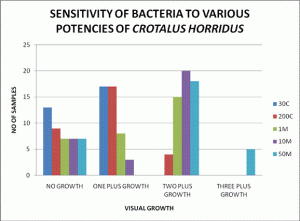
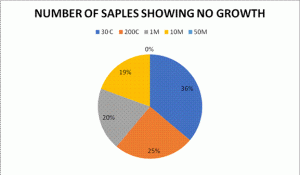
PHOTO SHOWING DILUTION METHOD EXPERIMENT FOR ANTIBACTERIAL ASSESMENT
PHOTO SHOWING WELL DIFFUSION METHOD OF ANTIMICROBIAL ASSAY
DISCUSSION
The study is to determine antibacterial activity of Crotalus against the P. aeruginosa. At the time of Hahnemann no microscope was invented so he could not gave justification for his theory of miasms. Also he could not give evidence that homoeopathic medicines are acting on infectious diseases. For this reason I chose my topic to check the antibacterial activity of Crotalus. After doing my study it was seen that Crotalus was acting on P. aeriginosa bacteria and inhibiting the growth of bacteria to some extent. The experiment also showed the MIC value that is the mean inhibition concentration of Crotalus potencies. The experiment was done with 20 drops of medicine of all potencies (30C, 200C, 1M, 10M, 50M). 30C, and 200C showed no visible growth while 90% alcohol and other remaining potencies showed + and ++ visible growth when compared with the negative control. The same experiment was done on 30 cultures of P. aeruginosa. The final result showed that Crotalus 30 C potency gave more inhibition than 200C, 1M, 10M or 50M. The MIC value was 20 drops of Crotalus in liquid potency.
According to homoeopathic principles the dynamic homoeopathic medicine requires an internal dynamic environment to act. Further study can be done on patients who are suffering from P. aeruginosa bacterial infection especially cases after burns. For more precise results the study can be done by using microtitre plates to know the exact rate of inhibition of bacteria.
SUMMARY
The study was done to determine the antibacterial activity of Crotalus produces similar symptoms to those of P. aeruginosa infection. This study was carried out in- vitro with the dilution method of antibiotic assay on 30 cultures of P. aeruginosa.
After study it was observed that 30 C potency of Crotalus gave the best results as compared to the other potencies. On some samples all potencies gave results, as there was no growth of bacteria when compared with positive control, negative control and test control of 90% alcohol.
The final result was Crotalus inhibits the growth of P. aeruginosa, especially in 30C potency.
REFERENCE AND BIBLIOGRAPHY
- Dikid, S K Jain, A Sharma, A Kumar, J P Narian, Indian journal of medical research 138, An Overview: Emerging and Reemerging infections in India, July 2013, Page No 19-31.
- Ananthanarayan and Panikar’s textbook of microbiology 8th edition, Page No 316.
- MateriaMedica of Homoeopathic Medicines- Dr. S R Phatak, Page no 220-223.
- Organon of Medicine, 6th edition, Dr. Hahnemann.
- Hahnemann’s Organon of Medicine, B.K. Sarkar.
- Antibacterial activities of some plant extracts used in Indian Traditional folk medicine.
By IndranilBhattacharyajee, SarojkumarChaterjee, AnupamaGhosh, Gautam Chandra.
Asian Pacific Journal of Tropical Biomedicine, volume 1, issue October 2011 Page S165- S169.
- Antibacterial activity of crotalid venoms against oral snake flora and other clinical bacteria. By David A Talan, Diane M Citron, Overturf, Gary D, Bret Singer, Philip Froman. The Journal of Infectious Diseases [IDSA- Infectious disease society of America]. Published in 1st July 1991.
- GC-MS Analysis and antibacterial evaluation of Acalyphaindica
By A. ZahirHussain and Kumaresan
PG and Research department of Chemistry, Jamal Mohamed College, Tiruchirapalli, Tamil Nadu, India.
Published in Pelagia Research Library- Asian Journal Of Plant Science and Research, 2013, 3(6):46-49.
- Comparative analysis of activity of providone iodine and Homoeopathic mother tinctures as antiseptics by Muhammad Moshin Zaman, Muhammad Aslam Shaad, Saeed Ahamad, Waheed Mumtaz Abbasi, Tayyeba Rehaman
Indian Journal of Research in Homoeopathy, Volume 10 Issue 1, January- March 2016.
- Repertory of Homoeopathic MateriaMedica, Dr. J T Kent.
- A Concise Repertory Of Homoeopathic Medicines, Dr. S R Phatak
- Pocket manual of Homoeopathic MateriaMedica with Repertory by Dr. Boericke. Page No 240,241.
- N M Choudhuri, A study on material medica, Page No 351.
- Materia Medica By Lippe
- Allens keynotes, H C Allen
- Microbiological Application By Benson
- RADAR Software, version 10.0.



